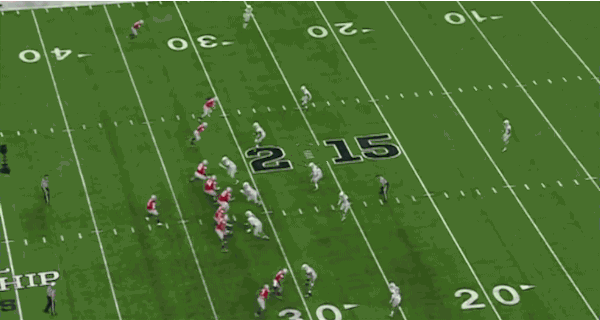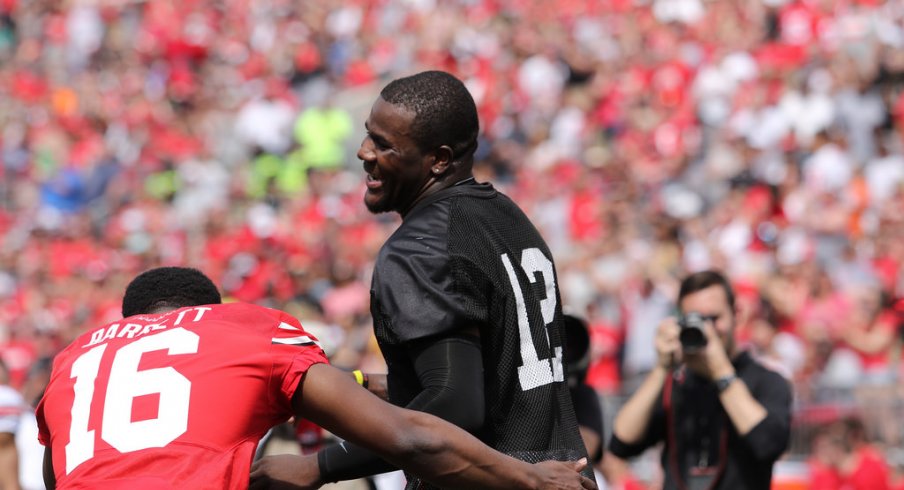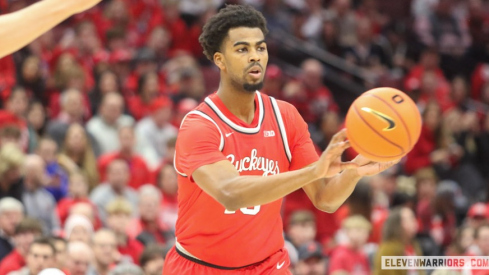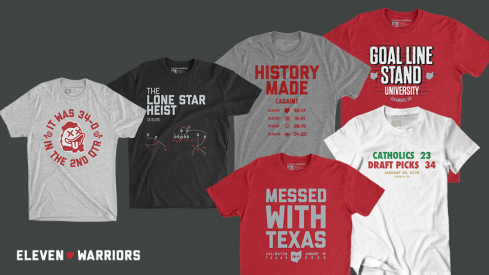No story will be more scrutinized during fall camp than the Ohio State quarterback situation. Head coach Urban Meyer has stated he will use metrics to determine a starter (and make no mistake, the decision is Meyer's to make).
Yet Meyer recently indicated he will also rely on his gut to make the decision — which is another way of saying how Meyer weighs any metric will depend upon what he prioritizes for his offense. Because what Meyer prioritizes will be more critical to making the quarterback determination than anything that JT Barrett or Cardale Jones may do. The question largely comes down to this — does Meyer prefer a downfield, pro-style passing threat? Or does he value operating his spread-read offense?
Meyer's decision may appear easier now that Braxton Miller's shoulder has insufficiently recovered to play quarterback, forcing Miller to the H slot receiver. But the very principles that Meyer values on offense almost assuredly means that Miller will receiver a sizable amount of reps under center — regardless of the health of his shoulder.
What do You Want?
It is not surprising that the Jones versus Barrett debate often comes down to what the commentator values from the quarterback position. Many NFL draftniks look at Jones and see a prototypical NFL quarterback. Many college analysts see Barrett's versatility as well-suited to Meyer's spread read offense.
Meyer's decision on a starter will likewise likely be driven to what he considers the most important attributes for a quarterback. Jones' arm strength brought a different dimension to the Ohio State offense during its three game playoff run. And it is not only his ability to throw vertically — it is how the deep threat opens up other aspects of the offense.
One such example is the intermediate passing game. As James Light discusses, fearing the vertical threat, Alabama head coach Nick Saban and defensive coordinator Kirby Smart chose to play their safeties in a 2-deep shell. This opened up deep crossing routes to slot receiver Jalin Marshall, resulting in several critical third down completions during the Buckeyes' second quarter comeback.

Jones' arm strength allows him to deliver such throws before the safety can react.

Deeper safeties, in turn, benefit the running game. It allowed Ezekiel Elliott to gain chunk yards before the safeties could react. And because the safeties were farther back, they had worse angles to pursue the football, resulting in explosive plays.
So it is not a coincidence that Elliott had his best games rushing with Jones at the helm. Without the fear of getting beat deep it is likely that opposing defenses such as the Crimson Tide would have crowded the line of scrimmage and challenged receivers more aggressively.
And Jones did more than alter defensive alignments. He demonstrated good pocket presence, was an effective scrambler and, perhaps most importantly, converted crucial short yardage situations on designed runs.
But Jones is not a versatile runner. He does not have the burst to attack the outside on plays such as quarterback outside lead zone. And he struggled with decision-making in the read run game.
A Swiss Army Knife
For his part Barrett is an excellent fit for Meyer's offense. Barrett is not just effective in the read game. He was also efficient on designed runs, demonstrating the versatility to run between the tackles or on the perimeter.
Nowhere was that more apparent than in short yardage situations, where Barrett runs north and south and keeps his legs churning. Light described the Buckeyes' split zone play with Barrett as the "most well executed and successful short yardage play" he witnessed in 2014.

All that is not to undersell Barrett as passer. He is an efficient quarterback — particularly when attacking the middle of the field.
And his good decision-making extends not just to the read game, but to run-pass option plays, where he is most effective. Such plays allow Barrett to quickly diagnose the defense, threaten with the run game, and deliver quick passes accurately and decisively.
But Barrett does not have Jones' arm strength to stretch a defense vertically — a problem that was most noticeable last season against Penn State. And after his excellent performance against Michigan State he was inconsistent late in the year. At times he sailed throws or was hesitant to deliver the football, requiring Meyer and offensive coordinator Tom Herman to rely upon him even more as a runner.
It is true that Barrett was only a redshirt freshman and certainly has room for improvement. But he does not have Jones' natural arm talent.
What'Ll It Be?
Since becoming a head coach at Bowling Green, Meyer's offense has been predicated upon two primary goals — re-equating numbers in the run game by using the quarterback as a run threat and putting the football in the hands of his playmakers as much as possible. Barrett may better fit these goals.
Meyer will have to decide the following. Does Jones' attributes offer bigger advantages — even if it limits the quarterback running game — requiring Ohio State to rely more heavily upon Elliott?
And the question no outsider can assess is how do Barrett and Jones' different personalities affect the decision — with Barrett as the consummate coach on the field as opposed to Jones' more freewheeling persona.
It Ain't Over Till It's Over
This is where Braxton Miller comes in. Despite Barrett and Jones' success as runners, Miller is the only true game breaking threat of the three carrying the football. If Meyer's yearly mandate is to identify his six top playmakers and get them the football, Miller will undoubtedly be at the top of his list.
Kyle identified ways Ohio State can use Miller from the slot. But the options are limited relative to receiving snaps at quarterback. From the H he can only threaten one flank of the defense — either the side he is on with screens, or the opposite side coming in motion on jet sweeps. Defenses can thus mirror his movements.
He can motion into the backfield as a halfback. But at quarterback Miller can attack any part of field and provides the offense a numbers' advantage. For instance, with lead quarterback runs such as outside zone or counter trey, the offense can use 3 and 4 wide receiver sets and still provide a lead blocker.

So it would be rash to think Braxton Miller's days at quarterback are over. Even if Miller takes the majority of snaps in the slot, expect Meyer to feature a package of plays with Miller under center — particularly if Miller's arm is healthy enough to occasionally throw.


